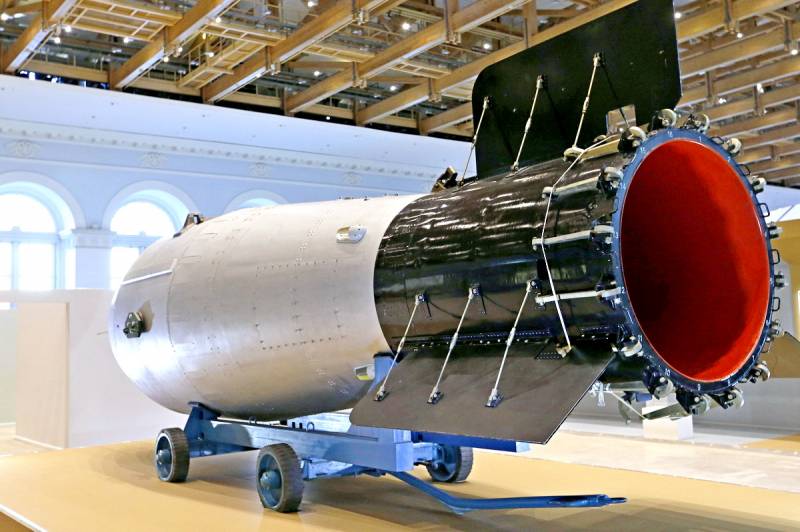Does Russia need a 100 megaton nuclear bomb?
The United States of America is openly preparing for World War III. President Trump has decided to withdraw from the INF Treaty, a key document guaranteeing international security. Next in line are START-3 and the Comprehensive Test Ban Treaty. At the same time, Washington is increasing its budget for modernizing the nuclear arsenal. It would be extremely naive not to see in all this a threat to our country.
The Pentagon intends to surround Russia with a picket fence from missile launchers and missile defense systems from the West and East in order to minimize the risk of retaliation. Unfortunately, today the Russian Federation is not in the best shape to compete on an equal footing with the United States in the arms race. And for some reason, the Americans are not afraid of our Zircons, what are we told earlier.
There are very serious doubts that our army will be able to "reach" not just Washington, but at least Lisbon. Famous military expert Konstantin Sivkov explains:
There is also an extremely unpopular opinion that Russia will not have enough of the entire nuclear arsenal to completely destroy the United States, which we also already told. Even in the event of a full-blown strike against modern anti-missile defense systems, no more than 20 million Americans will be destroyed, which for Washington, no matter how cynical it sounds, will not be unacceptable losses.
So what to do? Mentioned Konstantin Sivkov proposes to return to the Soviet concept of guaranteed retaliation with an unacceptable level of damage:
However, Russia’s nuclear club will not be enough for this. It is necessary to resurrect the famous thermonuclear “Tsar bomb”, but making it several times more powerful, bringing the force of the explosion to 100 Megatons, so that it could sweep away the enemy’s cities alone.
In the late 602s, the USSR created the AN1961 thermonuclear bomb as a response to Washington’s nuclear blackmail. During tests in October XNUMX, a bomb was dropped from an airplane over a test site on Novaya Zemlya. The force of the explosion exceeded more than three thousand times the bombs that the United States dropped on Japan. The outbreak was even seen in Alaska, and a blast wave three times circled the globe. Unfortunately, or, fortunately, the bomb did not go into series, but the mere fact that Moscow had it was enough for the warlike John F. Kennedy not to cross the last line and not start a nuclear war during the Caribbean crisis.
Today, the situation is largely similar. There is no real military parity between the United States and the Russian Federation, and Washington intends to strengthen its advantage. The answer in our realities can only be asymmetric and unimaginable in power. It will be enough to create 40-50 stomegaton thermonuclear warheads aimed at key US cities, tectonic fault lines and Yellowstone, to again make the American elite capable and understanding partners.
The Pentagon intends to surround Russia with a picket fence from missile launchers and missile defense systems from the West and East in order to minimize the risk of retaliation. Unfortunately, today the Russian Federation is not in the best shape to compete on an equal footing with the United States in the arms race. And for some reason, the Americans are not afraid of our Zircons, what are we told earlier.
There are very serious doubts that our army will be able to "reach" not just Washington, but at least Lisbon. Famous military expert Konstantin Sivkov explains:
Follow in the footsteps of the USSR will not work - a group of Ground Forces, which is guaranteed to defeat NATO and occupy Europe, can not be created for economic, demographic, or spiritual reasons.
There is also an extremely unpopular opinion that Russia will not have enough of the entire nuclear arsenal to completely destroy the United States, which we also already told. Even in the event of a full-blown strike against modern anti-missile defense systems, no more than 20 million Americans will be destroyed, which for Washington, no matter how cynical it sounds, will not be unacceptable losses.
So what to do? Mentioned Konstantin Sivkov proposes to return to the Soviet concept of guaranteed retaliation with an unacceptable level of damage:
There is only one way out - to make nuclear war irrational again, meaningless for the aggressor.
However, Russia’s nuclear club will not be enough for this. It is necessary to resurrect the famous thermonuclear “Tsar bomb”, but making it several times more powerful, bringing the force of the explosion to 100 Megatons, so that it could sweep away the enemy’s cities alone.
In the late 602s, the USSR created the AN1961 thermonuclear bomb as a response to Washington’s nuclear blackmail. During tests in October XNUMX, a bomb was dropped from an airplane over a test site on Novaya Zemlya. The force of the explosion exceeded more than three thousand times the bombs that the United States dropped on Japan. The outbreak was even seen in Alaska, and a blast wave three times circled the globe. Unfortunately, or, fortunately, the bomb did not go into series, but the mere fact that Moscow had it was enough for the warlike John F. Kennedy not to cross the last line and not start a nuclear war during the Caribbean crisis.
Today, the situation is largely similar. There is no real military parity between the United States and the Russian Federation, and Washington intends to strengthen its advantage. The answer in our realities can only be asymmetric and unimaginable in power. It will be enough to create 40-50 stomegaton thermonuclear warheads aimed at key US cities, tectonic fault lines and Yellowstone, to again make the American elite capable and understanding partners.

Information